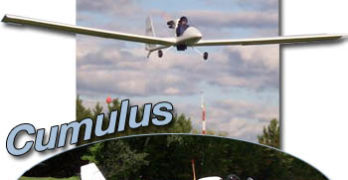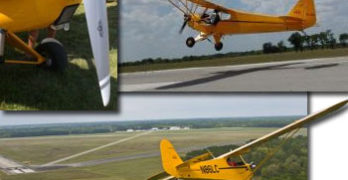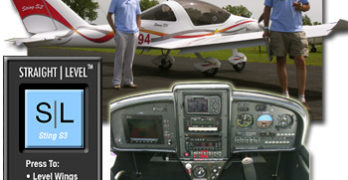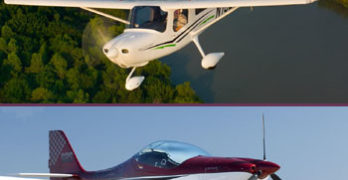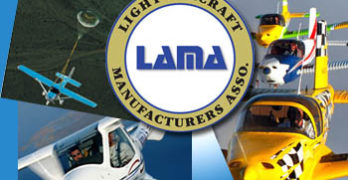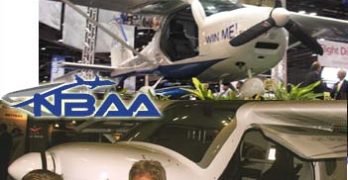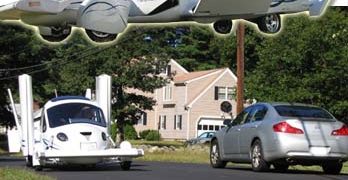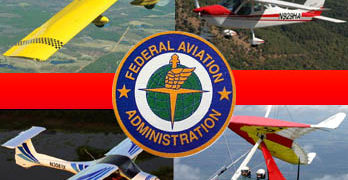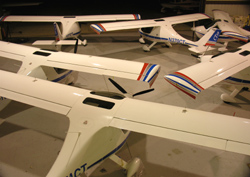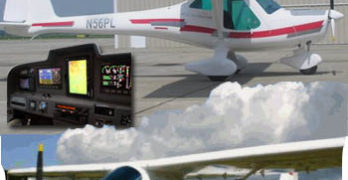In the 1990s I tried my hand at developing an airplane. While that business venture didn’t make me a millionaire, it provided a valuable lesson about what it takes to stay in the light-sport airplane business. Later, I realized the project needed someone who understood building techniques better than I did. That man was Dave Ekstrom and he ultimately took over my design, the Cumulus, a motorglider. He calls his business Ultralight Soaring Aviation LLC .
In the world of soaring, a motorglider is an expensive flying machine, making it not so different than high-end LSA that cost $130,000 or more. But Ekstrom comes from the world of homebuilts and he knew he could produce a kit for a lot less if buyers were willing to pull a few rivets (about 300 total hours are needed).
One of the 21 Cumulus builders is Andre Girard of Ottawa, Canada, who kindly provided Dave with the photos you see (five Cumulus kits are now airborne).
Light-Sport Aircraft Mature–Legend’s Celebration
Legend has good reason for celebration (and no, this has nothing to do with Obama’s election). In the lifespan of Light-Sport Aircraft — the first deliveries reach their fourth anniversary next April — Legend was an early success…a story that continues to unfold. The Sulfur Springs, Texas producer has come a long way while handily maintaining their status as, by far, the largest American-based producer of LSA. *** Recently, Legend celebrated the third anniversary of its first Legend Cub customer delivery. In August 2005, the builder handed over the keys to the company’s first newly manufactured Legend Cub to Rich Giannotti of Long Island, New York, launching the startup company. In the three years following, American Legend and their sibling kit company, Texas Sport Aircraft, report deliveries of more than 160 aircraft (not all SLSA). *** Along the way Legend has consistently added new features or options to the classic design.
Free Straight & Level Button for Sting S3 Owners
Recently I visited Cirrus Design. I saw progress on the Cirrus Vision jet and the new Garmin Perspective panel for the SR22. Both aircraft are full of high-end avionics. *** Down here in the world of Light-Sport Aircraft, we have far less costly choices for flat-screen avionic displays (panels in the Vision or SR22 literally cost more than an entire LSA). Yet the data each set of instruments uses is identical. LSA are also often equipped with autopilots…again, far less expensively compared to the certified units GA builders install. *** Recently SportairUSA announced their new “Straight & Level” button. If you find yourself in the soup unexpectedly, the pilot or passenger can push one button causing the autopilot to take over by guiding the airplane while the occupants assess their next move. It’s a brilliant idea to give pilots a breather. “The Straight and Level system is a significant advance in flight safety for Sting owners,” says Bill Canino, operator of SportairUSA, “That’s why we are providing it at no additional cost on all of ourTruTrak EFIS/autopilot equipped Stings.” The SL button even turns the autopilot on if it was off…a mighty smart airplane at a fraction of the cost of similarly equipped GA airplanes.
Flying through Turbulence; Even Big Boys Affected
Most producers in the Light-Sport Aircraft sector welcomed the LSA market entry announced by Cessna and Cirrus at Oshkosh 2007. July of last year looks like the “good old days,” as aviation from LSA to VLJs — essentially all of GA — is roiled by global economic uncertainty. *** Compounding the challenges, Cessna had an “unrecoverable” spin incident with their Skycatcher 162. Even BRS got drawn in with a rocket-deployed parachute that for reasons yet unknown didn’t save the airframe. Both companies are sure to work out these issues; test failures are an accepted part of aircraft development. *** Cirrus stepped down to a 3-day workweek (AvWeb article) to cope with slowing sales. Like Cessna, Cirrus is managing multiple developments. Their jet project consumes plenty of resources so when watching costs, it’s little surprise that the Duluth company might put their SRS Light-Sport project on the back burner.
LAMA Pushing Hard to Provide Audit Oversight
These days, “oversight” is a heavily used word on national media. But far from the strangeness of government bailouts is the world of Light-Sport Aircraft. For the new aviation sector, industry oversight is seen as critical by LAMA and many aviation leaders. *** A conversation with LAMA founder* Larry Burke shows the LSA industry organization is moving steadily toward its oversight goals. Insurance companies and others hope LAMA will audit companies supplying 80% of purchased LSA. Once that “critical mass” is reached, insurers feel they can advise customers do as LAMA encourages…”Look for the LAMA Label.” *** A LAMA audit verifies that a company which declares compliance to ASTM standards actually possesses the documentation to prove their declaration. After successfully passing a LAMA audit, a company can place LAMA Labels on their LSA so that potential customers are aware the company has satisfactorily completed a voluntary third party audit.
Hanging with the Jet Crowd; LSA at NBAA
Earlier it appeared that the Flight Design MC would be the first Light-Sport Aircraft ever displayed at the giant National Business Aircraft Association show. NBAA is the organization representing business jets plus a large range of exhibitors serving executive transportation. The trade show happening now in Orlando is a stupendous event with many more exhibitors than Oshkosh. Numerous displays are fantastic creations that cost more for a three-day show than LSA producers spend to market themselves for an entire year. *** So it is fascinating indeed that any LSA would be present at this event. And, in fact, two are seen by the bizjet crowd: the MC and Icon‘s handsome amphibious LSA project, the A5. Icon mounted their own display and reported good response, especially when one of their team hits the auto wing fold button. Even jaded aviators tend to have a jaw-drop reaction to this feature.
“New Wave” LSA, Part 1 — Terrafugia Transition
Recently, I visited three brand-new LSA developments. All are American. All are propelled by young engineers and enthusiasts. All are remarkably sophisticated. All companies have been successful at raising funds. And, perhaps most notably, all projects were started specifically because of the emergence of the Light-Sport Aircraft rule. *** All three are emphatically not reconfigured European microlights or vintage American designs…not that I have any objection to such aircraft. I am simply encouraged by fresh new designs from fresh young faces. Aviation needs that! *** My first example (others soon) is the Terrafugia Transition. Called a “roadable aircraft” rather than a “flying car,” Terrafuguia does what others have done but in a new, far more practical way. Compared to the Transition, Molt Taylor’s Aerocar is so last century. Transition folds its wings without leaving the cockpit. The company has produced a professional video that explains the concept and the award winning people behind it.
FAA Begins “Assessment” of LSA Industry
At Oshkosh, FAA held a meeting to announce their LSA Assessment Project. The agency that gave birth to Light-Sport Aircraft in the summer of 2004 is now embarking on a fact-finding tour they say will judge the “health of the industry,” part of their “aviation safety oversight.” Sounds rather ominous, doesn’t it? However, officials also stated clearly and repeatedly, “What this assessment and evaluation is not is an individual Light-Sport manufacturer’s compliance audit.” *** Indeed, Terry Chasteen, the new head LSA man in the Small Aircraft Directorate characterized the day-long visits by two teams of two inspectors as benign. He’ll be joined by Tom Gunnarson, former president of LAMA now with the LSA office. The visits started this week at Tecnam’s U.S. quarters; AMD, Aircraft Manufacturing and Design; Fantasy Air USA / LSA America; and P&M Aviation USA.
Light-Sport Aircraft Massing for Sun ‘n Fun
Lots more fun than a military build-up but bearing some resemblance, companies across the USA are preparing for Sun ‘n Fun starting Tuesday the 4th. I was on the grounds today and it already looks busy. I also traveled to Lockwood Aviation at the Sebring, Florida airport. A busy crew was assembling airplanes from Flight Design and Tecnam in preparation for the show in nearby Lakeland. Other companies set up at South Lakeland Airpark — the relaxed strip a mere three air miles from Sun ‘n Fun (where I do the majority of my flight evaluations). Today, I got a chance to compare a late-model 2005 CTsw with the 2006 model; look for the full report in EAA Sport Pilot for June 2006. Tomorrow, the folks at Sport Aircraft Works are hosting me to fly the Parrot, Sport Cruiser, and Mermaid from Czech Aircraft Works.
3Xtrim Navigator Is Newest SLSA (#86)
At Sebring 2007, I flew an enjoyable airplane from Poland with the uninspiring name of 3X55 Trainer (see my blog post). A re-engineered and renamed Navigator 600 received SLSA certification on August 22, 2008. [UPDATE 2/19/09] — The North American importer is 3Xtrim Inc. *** Navigator grew up and now boasts a 1,320 pound gross weight and a useful load of 600 pounds with a 47.2-inch cabin width, specified producer, 3Xtrim. I thought 3X55 looked small but she felt sufficiently roomy inside. 3X55 was also very straightforward to fly at modest speeds (88 knots at cruise). And it was so simple to land that the earlier model easily justified the “Trainer” label. *** [UPDATE 7/1/09] 3Xtrim, Inc., reports several N-numbered Navigator 600s are flying in the U.S. and four more are expected soon. Base price for a reasonably well-equipped Navigator is $99,000.
- « Previous Page
- 1
- …
- 44
- 45
- 46
- 47
- 48
- …
- 64
- Next Page »


